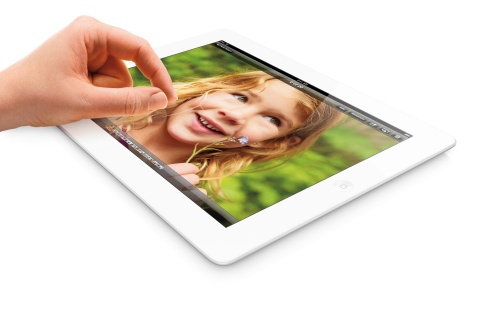The iPad mini stands apart from competitive 7.x-inch media tablets with its larger display, which is intended to offer a user experience that is closer to full-sized tablets — along with its use of the 4:3 aspect ratio, which makes it suitable to capitalize on the existing iPad ecosystem.
However, the mini display falls short of other comparable 7.x-in tablets in terms of its display resolution, according to the “IHS iSuppli Display Materials and Components Service” from information and analytics provider IHS (www.isuppli.com).
“Apple has thrown its hat into the ring for smaller-sized media tablets with the iPad mini, putting it into direct competition with alternative devices such as Google Nexus 7, the Amazon Kindle Fire HD and the Barnes & Noble Nook HD, ” says Vinita Jakhanwal, director for Small & Medium Displays at IHS. “However, by using a bigger display with a larger viewing area for the iPad Mini, Apple is trying to offer a media tablet that’s physically smaller than other iPads, but doesn’t totally compromise the user experience delivered by the larger members of the iPad line. But, it differs by sticking with the 4:3 aspect ratio used in other iPads, rather than the wider aspect ratio of16:10 employed by competitors — a dimension that can be better suited for displaying high-definition video content in the landscape mode.”
Despite the tradeoffs, Apple historically has been extremely shrewd in picking which features will appeal to consumers for its media tablet and smartphone products, and IHS believes the mini will continue the company’s winning streak with the 7.9-inch, 4:3 aspect ratio design, ready to tap into the existing base of applications already developed for the iPad 2.
Some experts were expecting the mini to be less expensive, and downgraded their shipment forecasts based on Apple’s announced pricing. However, the pricing conformed with IHS iSuppli expectations, and continued Apple’s pattern of offering premium-priced media tablets and smartphones that are highly successful in the market.
The iPad mini comes equipped with a 7.9-inch display. In comparison, the other brands have displays nearly 1-inch smaller, at just 7.0-inches.
The larger screen size of the mini leads to a bigger display viewing area — 35 percent greater than the other media tablets with 7-inch displays
Furthermore, the bezel width on two sides of the Mini’s display has been reduced, decreasing the breadth of the device. The overall size of the Mini is only 13% larger than the Google Nexus 7, but the mini’s display area is 35% bigger.
When compared to the Kindle Fire HD, the total size of the Mini is about the same. But similar to the Nexus 7 comparison, the display area of the Mini is 35% bigger — again, a case of clever designing to offer more viewing real estate without impacting the device form factor.
The Mini’s display has a pixel format of 1,024 by 768 pixels, resulting in a resolution of 163 pixels per inch (PPI). This is lower than the other 7.x-inch displays, whose resolutions are greater than 200 PPI. The Nook HD, for instance, has a resolution of 243 PPI, putting it closest to the 264 PPI Retina display resolution of the new iPad and the newly launched fourth-generation iPad.
The resolution of the iPad 2 is 132 PPI and with the same pixel format as the iPad mini. Although the resolution is lower for the mini, the smaller iPad offers compatibility with the multitude of apps developed for the iPad 2 that continue to be sold in the market.
All the iPads, including the mini, use an aspect ratio of 4:3 for their display. The other brands like Amazon, Barnes & Noble and Google use a 16:10 aspect ratio. The recently launched iPhone 5 moved to a 16:9 aspect ratio. In a 4:3 aspect ratio display, HD video content that isn’t letterboxed will be displayed with black bands above and below the video. The wider aspect ratio (16:10) improves viewing experience of video and game-based multimedia content, making such displays more suitable for devices meant primarily for the consumption of video content.
Viewing content in the portrait mode is better supported by a 4:3 aspect ratio, however, and may be better suited for multiple-use devices employed in viewing web pages, books and magazines. The 4:3 aspect ratio also increases the screen area on a same-sized display when compared to a wide aspect ratio display, and may require less scrolling to view the content.
The iPad mini is also a much thinner device compared to the other tablets in the 7.x-inch category. The device’s thickness is only 0.28-inches, or 7.2mm, compared to 0.41-inches for the Google Nexus 7 and 0.45-inches for the Kindle Fire.
The display technology for the Mini continues to be in-plane switching liquid crystal display (IPS LCD), which is used in most 7.x-inch branded tablets. However, improvements have been made from the previous-generation iPad displays to make the Mini’s screen slimmer and lighter.
The mini’s slim design is partly due to its battery, the thinnest single-cell battery ever made by Apple. However, it’s also likely that changes have been implemented in the touch screen design. IHS believes that the glass layer that houses the touch sensors in the larger iPads has been replaced with plastic film for the Mini..
In terms of device weight, the mini at 0.68 pounds is the lightest among the other top 7.x-inch tablets, despite having a larger screen size and area. The Nook HD isn’t that far behind at 0.69 pounds, but it uses a smaller 7.0-inch display.


